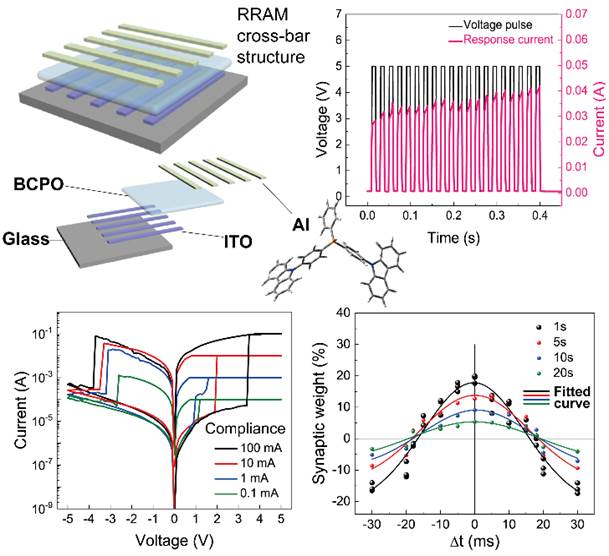Student Jingyu Mao from Ye Zhou’s group recently published a paper titled “A bio-inspiredelectronic synapse using solution processable organic small molecule” in J. Mater. Chem. C (Impact Factor 5.976 ), which was the second paper published in JMCC as the first author.
The simulation of biological synapses by RRAM would become the basis of artificial intelligence components in the future. The preparation of RRAM with low cost and solution method is a research focus in this direction. In collaboration with Prof. Hexiu Zhou from National Tsing Hua University, the research team reported a resistive memory and neuromorphic device based on BCPO, which has stable resistance transition behavior, long data retention time, high switching ratio and good thermal stability. Calculations by Kelvin probe microscopy, conductive atomic force microscopy and density functional theory show that redox state and space-confined charge are the causes of resistance transition behavior. In addition, the device can simulate the basic functions of biological synapses, including stimulation frequency-dependent synaptic plasticity, time-dependent plasticity, and short-term to long-term memory transformation. Low temperature solution BCPO organic layer is conducive to the preparation of flexible and printable electronic products, and it is believed that this electronic synapse can be used in the calculation of future nerve morphology.
Jingyu Mao graduated from IAS with Honor Degree in 2014 and currently study for his graduate degree at IAS. He joined in research scientist Ye Zhou’s group on the sophomore summer vacation to accumulate research experience and he have published several articles in famous journals, such as Adv. Funct. Mater., Mater. Horiz., Small, J. Mater. Chem.C.. This work was supported by the grants from Natural Science Foundation of China, the Education Department, Guangdong Provincial Department of Science and Technology, the Department of Education of Guangdong Province, the Science and Technology Innovation Commission of Shenzhen.
Ref: https://pubs.rsc.org/en/content/articlelanding/2018/tc/c8tc05489d#!divAbstract




